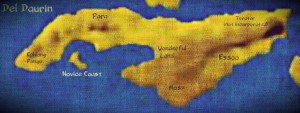
This is the continent of Del Daurin:

It’s almost 1.2 million square miles, and has tens of millions of inhabitants. Over the years, these inhabitants have mostly agreed to assimilate themselves into one nation, known unofficially as Del Daurin Greater. They have yet to agree on an official collective name. Talks are ongoing, and have been for the better part of a century. There are six semi-autonomous regions, or states, in Del Daurin Greater and one currently unincorporated territory. These states have agreed to divide themselves roughly along these lines:

The writers of Blythe Magazine recently characterized each state using only two terms each to summarize giant swathes of the population. For example: Para: Big, Important; Ephlong Pongo: Rheas, Minotaur Mountain; Essoo: Garbage, Disembodied Floating Prophetic Head. And so forth. A crude and misleading characterization, but entertaining nonetheless.
There are many forests, deserts and mountain ranges on Del Daurin. More on that later. Occasionally, you will see this flag flying from senior citizens’ homes, or else from post offices:

The states generally get on well, and hardly ever fight outright. The state of Essoo has been ostracized many times, but that seems to have been politically motivated more than anything. For the casual visitor to Del Daurin Greater, each of the states offers unique experiences, vibrant cultures, and unforgettable surprises. You can visit the yawning chambers of the National Governing Building in Para, dig in the sand dunes in Mosz, or buy a variety of colorful shirts in Novice Coast. Get your future told in Essoo, ride a monorail across Wonderful Land, or watch a genuine Minotaur being built in Ephlong Pongo.
Government
They govern themselves with a representative continental congress, as well as a president-elect. There are many levels of government, from the national arena down to the neighborhoods. They behave how you might expect.
History
Prior to 1784, Del Daurin was composed of regions either ruled by kings (or emperors or whatnot) or else wilderlands where there wasn’t any incorporation. The area known as Paragon Valley began to incorporate into one large state with cities in the 1770s. This worked out well for them, and the land to the west, which was at that time two large kingdoms known as Ephlong and Pongo became interested in the wealth that was being generated in the Paragon Valley. After talks and skirmishes, the kingdom of Pongo joined the Paragon Valley and became the nation of Para-Pongo. This was in 1784.
In 1792, the island nation of Novice Coast, as well as the original Ephlong region joined the nation of Para-Pongo, which was renamed Western Del Daurin. At this time, Western Del Daurin was composed of four states, Paragon Valley, Pongo, Ephlong and Novice Coast. The states of Ephlong and Pongo officially joined to form one state in 1823, largely because people had difficulty telling them apart anyhow.
In 1835, the sparsely populated area known as Mosz in southern Del Daurin was annexed into Western Del Daurin, which was renamed Del Daurin Greater (though not officially). The same thing happened in eastern Del Daurin with the region known as Essoo in 1859. This proved to be problematic because that is a wild land with lots of issues. They were stripped of statehood in 1863.
In 1885, the large swathe of land north of Mosz that at one time contained the ancient civilization of Vaz Chapa was inducted as a state, along with Essoo again, as a goodwill gesture. This became the state of Wonderful Land. Prior to this time, it was believed that there were still those who considered themselves to be Vaz Chapas, and they would not agree to joining Del Daurin Greater. After a while, nobody claimed this anymore because it was too hard to live in the desert when there were nice cities to the south and north.
In 1903, Del Daurin Greater attempted to annex the remaining continental region known as Terratar into the nation. The inhabitants of Terratar rejected this notion, though not collectively, as they were not a collective. From 1910 until 1916, there was a war with Terratar for not paying taxes, abiding by national laws, and basically just ignoring Del Daurin Greater. A treaty was signed in 1916 allowing them to remain unincorporated territory. In 1950, there was a large athletic event held in Terratar as a sign of goodwill. It was called the Good Neighbor Games. It was sparsely attended.